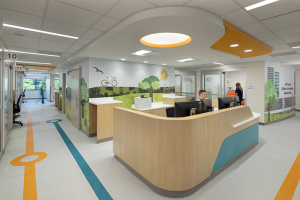Patient-friendly Wayfinding
Preeti Dhindsa | Business Development Manager and Lillyan Wamaitha | Customer Experience Manager.
In today’s healthcare environment, patients are frequently regarded as customers and caregivers are regarded as service providers. This shift makes improved customer experience extremely important. Wayfinding has the potential to impact customer experience by making facilities easy to navigate, reinforcing the first-time visitor’s ability to get around, and reducing patient anxiety. When people can confidently and safely navigate a space and are able to develop positive interactions within it, the frequent outcome is loyalty and long-term engagement.
Navigation is a human process. It is about our individual perception of a space and how we process information and make decisions. It then follows good wayfinding design that needs a good understanding of human behavior and psychology.
What do Patients Want?
Hospitals get lots of anxious visitors seeking help and trying to find their way. Most will be proactive and seek out information from a static sign, digital screen, and pamphlet or hospital employee. Others will read up on the hospital or their illness. Whatever approach each visitor takes, they’re all looking for options and answers. They’re actively seeking to become a knowledgeable consumer of health care services.
To satisfy this need, wayfinding should be cohesive and part of a multi-channel strategy instead of a stand-alone solution. Effective wayfinding is holistic where different solutions e.g. digital signage, mobile wayfinding, color coding, furnishings, etc. are incorporated and are able to ‘talk to each other,’ and the flow of information from channel/solution to the next is natural and seamless.
The patient journey begins before they arrive at the hospital. It starts when they make a doctor’s appointment, book a procedure, or schedule a visit. They may use their phone, tablet, or computer at home to get directions or plan their journey. When they get to the hospital, a static signs shows them where to park and what building to go to. A video wall can show them the general direction of the department they’re looking for (e.g., maternity, which they’ll know by the furnishings or color scheme.)
The wayfinding video wall can surround the hospital map with dynamic content such as customized RSS/MRSS feeds, emergency alerts (both custom and common alerting protocol (CAP) all-hazard and public warnings),live traffic, social media, HTML5 scripts, etc. Mixing this information with the wayfinding map makes the video wall a destination hub where visitors can collect information as they continue to navigate the hospital. It shapes the way patients read and react to their environment.
When the patient gets to the department they’re looking for a kiosk that can offer them the opportunity to chart their course to a specific office, download doctor information to their phone, or view peak or wait times.
Such seamless organization is what people are looking for and is one of the pain points wayfinding should address.
What Digital Wayfinding Gives your Patients
Digital wayfinding is gaining a lot of traction due to the numerous wayfinding pain points it addresses.
For one, the navigational assistance provided is holistic. It takes on a comprehensive approach to fully orient patients. A wayfinding network can include digital building directories to label buildings and inform patients about the occupants; interactive wayfinding kiosks can guide patients and provide more detailed information; and check-in kiosks can give visitors access to appointment information, billing, and more.
Digital wayfinding also helps to personalize experiences. Perhaps the best demonstration of how digital wayfinding does this is through the use of smartphones. A 2010 survey by Nielsen shows navigation as one of the most popular app categories amongst smartphone users, after games and weather. Since patients are already using their phones for navigation, it’s natural to provide wayfinding on their phones.
Building wayfinding maps on responsive HTML5 and hosting them online is one way to facilitate mobile wayfinding. Visitors will be able to access wayfinding from multiple locations: kiosks, computers, tablets or phones.
Including a QR code in wayfinding also enables mobile wayfinding. Visitors can chart their course on an interactive kiosk and use the QR code to download the map. The QR code will launch a URL of the building's wayfinding map, allowing your visitors to take your maps with them. The map can include personalized information such as estimated walk times, distance, etc.
SMS also allows visitors and patients to get wayfinding maps and additional information on their phones. Turn by turn directions via text are easier to understand and personalize the wayfinding experience. The SMS feature can also be programmed to respond to certain triggers and send personalized information such as images, contact information, addresses etc.
Beacons—small wireless, battery-operated devices mounted at entrances, elevators, and other landmarks—are also being tested as a way to facilitate wayfinding via smartphones. Beacons use Bluetooth and the health care provider’s app to talk to smartphones and feed patients directions to their destination. For example, the patient gets a photo of where they’re going and simple directions like “take the elevator to the 3rd floor.” When they exit the elevator, the next beacon guides them down the hall in the right direction.
Smartphones will be an important piece in omnichannel wayfinding. Seeing as how patients are attached to it, it’ll be important in wayfinding that passes along the patient’s preferences and helps customize the experience as the patient moves through the space. The next wave of mobile wayfinding will be blended into overall hospital communication and tell patients where they are, where they need to be, and what they need to do when they get there.
The people that use the space should be the focus of any wayfinding system. As patients become more sophisticated in the way they communicate, wayfinding will become an even more important aspect of the patient experience and technology will be a major driver for the direction it moves in.




